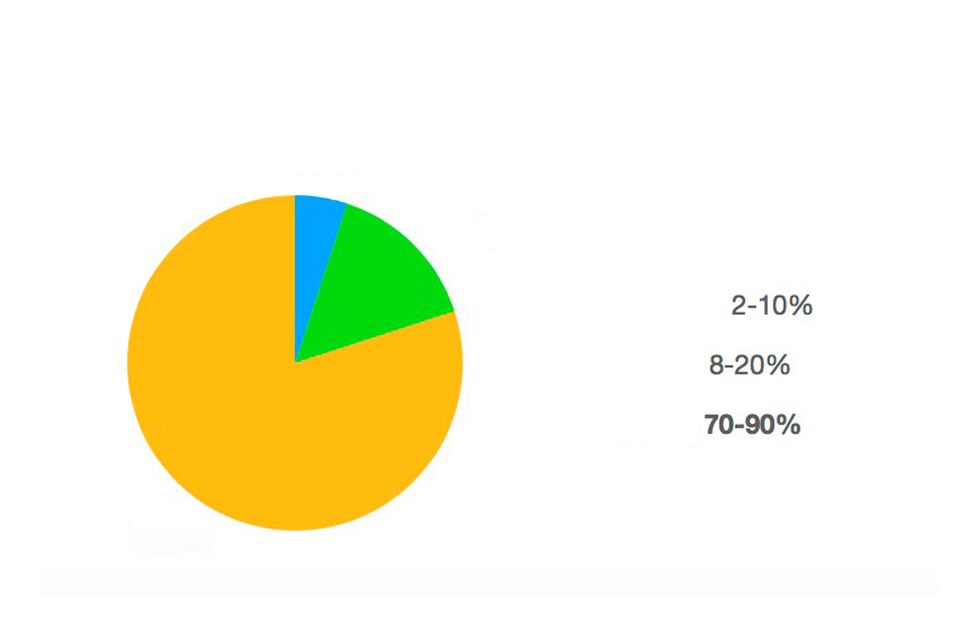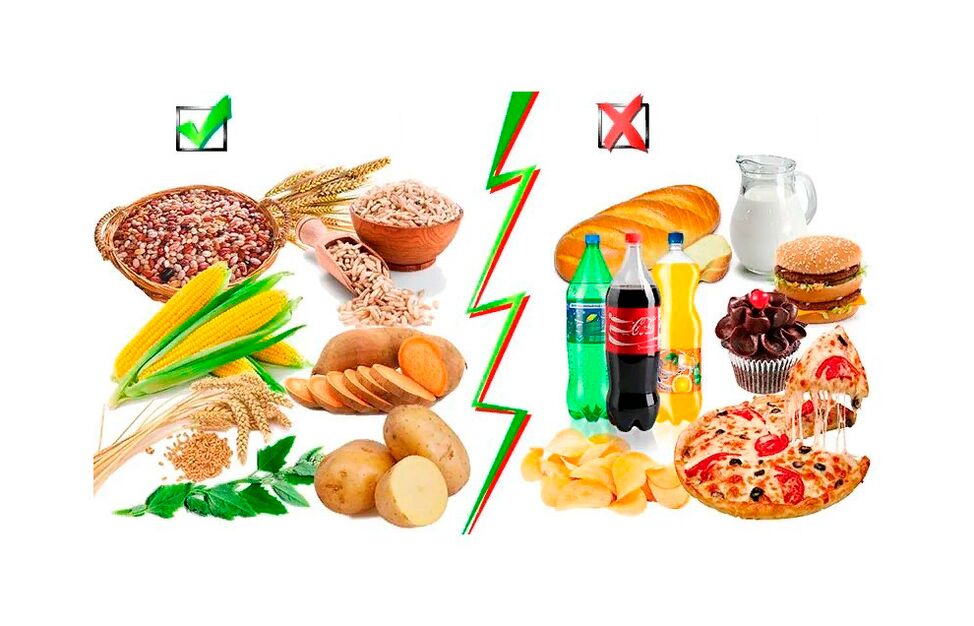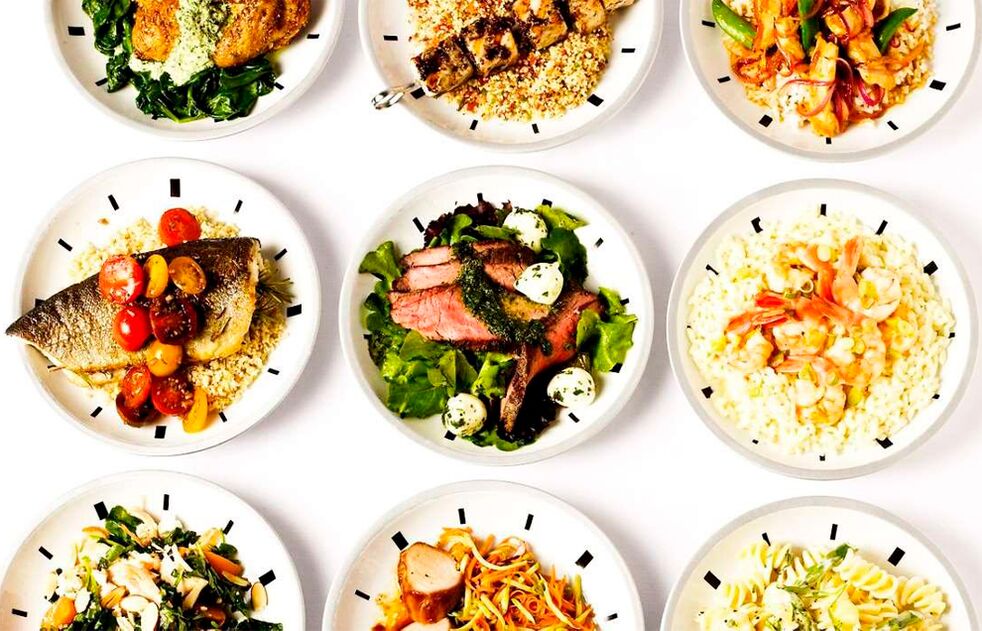A carbohydrate-free diet is an extreme version of a low-carbohydrate diet that consists of protein, healthy fats, and fiber.
Our body generally uses carbohydrates (glucose) to provide energy to the body and the brain. Their decrease leads to a decrease in insulin production in the body, as a result of which it begins to break down proteins (muscle stores) and stored fats as an alternative source. This leads to rapid weight loss.
Depending on age, weight, physical activity and goals (weight loss, gaining muscle mass, dehydration), the body requires different amounts of protein, fat and carbohydrates (BJU). According to experts, the average daily consumption is as follows:
- 45-65% carbohydrates
- 20-35% fat
- 10-35% protein
With a low-carb diet, fats become the main source of calories, and carbohydrates are reduced by 2-10%.

The general principles of a carbohydrate-free diet are:
- The amount of carbohydrates consumed is reduced from 0 to 30 grams per day.
- Make sure you drink at least 8-12 glasses of water a day to remove toxins from your body.
- Since most of the diet consists of proteins and fats, you should pay attention to their benefits. It is important to reduce the consumption of trans fats and not use too many saturated ones. For example, a study in 2018 claims that low-carbohydrate diets, which prefer vegetable proteins and fats to animal sources, are associated with lower mortality. In addition to cutting your back, think about your long-term health.
- With so many foods, it's almost impossible to give up carbs altogether. But first of all, those with a glycemic index above 50 should be avoided.
Today, the least carbohydrate diet is the keto diet, where the BJU ratio is 75% fat, 20% protein and 5% carbohydrate. In addition, one of the most popular and popular is the Ducan diet, which is the basis of a diet high in protein.
Advantages and disadvantages of a carbohydrate diet
Any diet is limited and stressful, so it is important to evaluate all the pros and cons of your future regimen before experimenting with nutrition.
Benefits of a carbohydrate-free diet
- Replacing carbohydrates with proteins affects ghrelin, a hunger hormone, which makes you feel full and can reduce the intake of snacks and daily calories.
- Weight loss will be faster in the first weeks. This is primarily due to a decrease in fluid intake. Foods rich in carbohydrates not only contain a lot of water, but are also eliminated through metabolism. For this reason, a carbohydrate-free diet is preferred by those who want to lose weight quickly. A study of 79 obese adults showed that those who consumed less than 30 grams of carbohydrates per day for 6 months lost about 4 kg more than those who restricted fat intake.
- Carbohydrate intake has a significant effect on blood sugar and insulin levels. Excess glucose is associated with many health problems, such as type 2 diabetes, cancer and cardiovascular disease. Low carb diets reduce these chances.
- According to research, a carbohydrate-free diet can reduce the symptoms of Alzheimer's and slow down its development.
Disadvantages of a carbohydrate-free diet
- By reducing the amount of carbohydrates consumed, insulin levels decrease and the hormone glucagon increases, which causes the body to burn fat. However, when the body goes into this form of fat burning, a process called ketosis occurs and compounds called ketones accumulate in the body. This process can cause nausea, headache, halitosis, fever, sleep disturbances, etc. May cause side effects including. In addition, fatigue and drowsiness are often observed. Therefore, in everyday life, there are problems such as significantly reducing the number of exercises and deteriorating the quality of their performance.
- A low-carb diet inevitably leads to fiber deficiency. Many studies show that the movement of beneficial bacteria in our intestines is important for overall health when consuming dietary fiber. Bacteria work on fiber, forming short-chain fatty acids that inhibit the growth of harmful bacteria, protect intestinal health, and have anti-inflammatory and antimicrobial effects. In addition, it is difficult for such a diet to provide the body with sufficient amounts of vitamins, especially B and C groups, and minerals such as potassium.
- Prolonged adherence to a diet can increase the risk of high cholesterol, osteoporosis, abnormal heart rhythms and kidney problems.
- The most common side effects of a carbohydrate-free diet are constipation or indigestion.
Who is not suitable for a low-carbohydrate diet?
- People with diabetes or chronic diseases that require close monitoring of blood sugar levels.
- People with problems of the cardiovascular system, blood pressure and gastrointestinal tract.
- Pregnant and lactating women.
- Older people, adolescents and those with low body mass index.
- People with emotional or psychological problems related to nutrition.
Before trying a carbohydrate-free diet, consult a specialist to avoid harm.
General rules for eating a carbohydrate-free diet
Low-carbohydrate foods mainly contain fats: coconut, butter or olive oil, olive (virgin), avocado oil, etc.
While all fats and oils are 0 or minimal in carbohydrates, not all are healthy. Some oils are processed and contain chemicals. In addition, most vegetable oils contain large amounts of omega-6 fatty acids, which can cause inflammation when consumed in excess. These oils can inhibit the anti-inflammatory activity of other oils, such as omega-3.
For this reason, it is better to avoid fats that are high in omega-6 fatty acids, such as soy, corn, rapeseed and peanut oil.

Since the diet will consist mainly of meat, which consists of protein and fats, make sure that it is high quality and ideally organic, as their main purpose is to increase the taste of the product and prolong its shelf life. Try not to buy processed meat products. Many manufacturers add sugar, spices and flavors to increase the amount of carbohydrates.
Although dairy products contain carbohydrates (sugar in the form of lactose), in most cases they are insignificant. Sour milk can provide protein, calcium, vitamin D and potassium. Milk and yogurt are the most carbohydrates, but if you are not ready to cut them completely, it is important to choose products that do not contain additional sweeteners or flavors, and watch the number of servings.
Special attention should be paid to food processing. For a diet, use recipes that include boiling, cooking, and steaming. Cooking is useful. And it is better to completely avoid fried foods.
You should also choose foods with a low glycemic index (up to 50). It is full of slow carbohydrates that break down for a very long time and give a feeling of satiety. In general, it is worth remembering that fats are not derived from carbohydrates, but from a high-calorie diet and a sedentary lifestyle.

What foods should you eat and avoid in a carbohydrate-free diet?
Healthy foods low in carbohydrates
- Meat and low-carbohydrate animal products: chicken, beef, turkey, lamb, pork, eggs, butter, cheese
- Seafood: salmon, catfish, cod, shrimp, sardines, herring, anchovies, trout
- Spices: herbs and spices
- Low calorie drinks: water, black coffee and tea
- Hazelnuts and Seeds (Low Carbohydrate): Almonds, Walnuts, Pumpkin Seeds, Sunflower Seeds, Peanuts, Cashews
- Non-starchy vegetables and fruits rich in oils: broccoli, squash, bell peppers, eggplant, cucumber, cauliflower, leafy greens, Brussels sprouts, celery, asparagus, mushrooms, coconut, avocado
Foods to avoid
A carbohydrate-free diet severely limits and excludes several food groups:
- Cereals and grains: rice, barley, quinoa, wheat, bread, pasta
- Sweets and confectionery: cakes, cookies, candies
- Carbonated and sugary drinks
- Fruits and berries: apples, oranges, bananas, kiwis, pears
- Starchy vegetables: peas, corn, pumpkin, potatoes
- Legumes: beans, peas, lentils, peas
- Dairy products: milk and yogurt
- Spices with added sugar: ketchup, barbecue sauce, salad dressings
- Alcohol: beer, wine, beverages, sweet cocktails, port wine, vermouth
Carbohydrate-free menu for a week
Although the list of available foods is significantly reduced, the diet can be varied. An example of a menu for a daily carbohydrate-free diet.
Monday
Breakfast: omelette with mushrooms
Lunch: beef broth
Dinner: oven-baked turkey fillet with asparagus
Tuesday
Breakfast: flaxseed bread, guacamole and boiled eggs
Lunch: miso soup
Dinner: pumpkin baked in the oven with cheese
Wednesday
Breakfast: salad with salmon and avocado
Dinner: broth with chicken meatballs
Dinner: pasta with bacon and cream sauce
Thursday
Breakfast: salad with chicken, cucumber, feta and spinach
Dinner: steamed pumpkin noodles with chicken cutlet
Lunch: Peppers stuffed with seafood
Friday
Breakfast: cottage cheese casserole
Dinner: mushroom soup
Lunch: steak and green vegetables
Saturday
Breakfast: eggs with pork
Dinner: brown rice with trout
Dinner: cabbage cooked with meat
Sunday
Breakfast: oatmeal with a little almonds and boiled egg
Dinner: boiled chicken with green peas
Lunch: seafood and green vegetable salad

Keep in mind that a complete and long-term ban on carbohydrate intake is excessive, and excessive dietary habits bring little benefit. A proper diet should be balanced and contain all the vitamins and nutrients the body needs to function effectively. Experts differ on a low-carbohydrate and low-carbohydrate diet, but they all agree that such a diet should be short-lived and not more than 2 months in a row.














































































